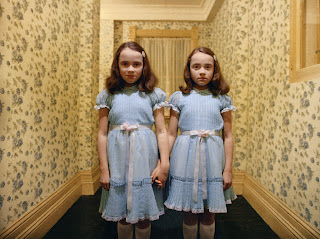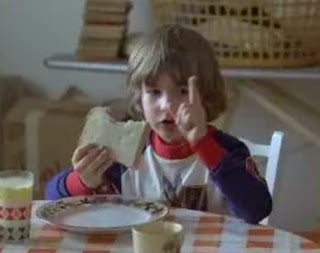Figure 1, (2011), still of Jack
Figure 2, (2011), still of murder scene illusion
There was a lot of suggestion to the uncanny used to depict the ghosts/echoes, The twin girls that haunt Danny have a doll - like appearance and dressed identically to indicate the idea of a perfect double. The woman that haunts the room that musn't be opened appears as a beautiful young girl but transforms into a horrible cackling old woman creates the idea that her intent is to deceive men who enter it, Jack discovers the transformation as is kissing the younger version of the woman and is suddenly repulsed by her because she is no longer the familiar young beauty. Mirrors were strong within the film to reveal true characters and their intentions, they suggested a transformation taking place in the character of Jack as the audience could view his creepy expressions in the mirror as if an evil double was slowly surfacing. This theme was also explored in the character of Danny because throughout he had an imaginary friend called 'Tony' and took on two personalities when he was talking suggesting that Danny has two identites conflicted within and that the sweet innocent stereotype has a form of insanity.
Figure 3, (2009), still of Grady sisters
Figure 4, (2011), still of danny
The use of steady cameras to capture the slow errie theme of the film provided the intense build up of something that is evitable such as the scenes where the camera is following Danny in his toy bike along a narrow corridor and leading up to a horrific scene. It also helped to track the vivant sense of a shadow looming into view and the footprints in the snow captured during the maze scene. They created the impression of someone being stalked and hunted because of the luminous white of the snow. "Kubrick's use of space and the eerie steadycam have never been put to better use." (Anderson, 2005), the quote links back to how the steadycams help to make the sets appear more creepy and lead up to something that is about to happen.
There are subtle written clues that hint the direction which the plot is about to take, the red rum warning is one example because Danny keeps repeating these words at different points of the film, while they are staying in the hotel. The audience is completely clueless even when he writes on the door because it is only read as Red Rum, until Wendy sees the message reversed in the reflection of the mirror. The warning is suddenly made clear depicted as Murder just before Jack crashes through with his axe. Another example is the repeated message on the pages from the type writer 'Work and no play makes Jack dull', the idea of this repetition of a sentence strengthens the truth. Wendy realises that her husband has totally been taken control from his insanity, which was further strengthed by her horrific screams and emotion of real fear.
Figure 5, (2011), still of red rum warning
The soundtrack was the strongest element that helped the film to flow and create the tension because it was classic piercing and shrieking sounds to capture the intensity of the points where a scene appears disturbing. The soundtrack was also used to mark the different days and times to instantly impact the fact that the next day of the tale has began but also reforces how the little events build up to the climatic ending. The soundtrack was the obvious tool that outlined that the hotel was actually unhomely and that the family was slowly transforming from a typical household into a disfunctional family with a father intent of harming his wife and child, becoming the psychotic muderer. "...the film has some of the most beatiful, atmospheric cinematography, by John Alcott, I have ever seen. Other technical credits are also superb, including the extremely eerie, memorable instrumental music score by Herbert Von Karajan." (Putman, 1998), the evidence indicates how the soundtrack strengthened the eerie atmosphere of the film because of it's strong connection to the horror theme.
Figure 6, (2011), still of Wendy screaming
Illustrations
Figure 1, (2011), still of Jack, @ http://www.fanpix.net/0676496/011997301/the-shining-1980-picture.html, Accessed on: 2011
Figure 2, (2011), still of murder scene illusion, @ http://moviescrunch.com/the-shining-movie-review-1980/, Accessed on: 7th January 2011
Figure 3, (2009), still of the Grady sisters, @ http://blog.scad.edu/ereber/, Accessed on: 9th February 2009
Figure 4, (2011), still of Danny, @ http://www.fanpix.net/picture-gallery/0676496/the-shining-pictures.html,
Accessed on 2011
Figure 5, (2011), still of red rum warning, @ http://movies.yahoo.com/movie/1800116994/photo/535403, Accessed on: 2011
Figure 6, 2011, still of Wendy screaming, @ http://www.fanpix.net/0676496/011997306/the-shining-1980-picture.html, Accessed on: 2011
Bibliography
Anderson Jeffrey, (2005), Combustible Celluloid, @ http://www.combustiblecelluloid.com/classic/shining.shtml, Accessed on: 6th December 2005
Ebert Roger, (2007), Chicago Sun-Times, @ http://rogerebert.suntimes.com/apps/pbcs.dll/article?AID=/20060618/REVIEWS08/606180302, Accessed on: 8th May 2007
Putman Dustin, (1998), dustin's review - The Shining, @ http://themovieboy.com/reviews/s/80_shining.htm, Accessed on: September 1998









No comments:
Post a Comment